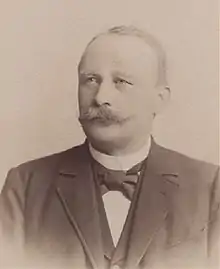
Alfred Hillebrandt
Alfred Hillebrandt (15 March 1853, in Groß Nädlitz – 18 October 1927, in Deutsch-Lissa) was a German Sanskrit scholar.
Biography
He studied Sanskrit and comparative linguistics at the University of Breslau as a student of Adolf Friedrich Stenzler, then continued his studies at the University of Munich under Martin Haug. In 1883 he became an associate professor at Breslau, where in 1887 he attained a full professorship. On two separate occasions he served as university rector.[1]
His specialty was Vedic mythology. "Varuna und Mitra, ein Beitrag Zur Exegese des Veda" (Breslau, 1877) was a prologue to his great work "Vedische Mythologie" (1891-1902), which was later translated into English and published as "Vedic mythology".[2] Hillebrandt also wrote:
- Das altindische Neu- und Vollmondsopfer (The ancient Indian new and full moon sacrifices, 1880).
- Vedachrestomathie (Vedic chrestomathy, 1885).
- A section on religious antiquities in Georg Bühler's Grundriss der indo-arischen Philologie und Altertumskunde (1897).
- Alt-Indien, Kulturgeschichtliche Skizzen (Historical culture sketches of ancient India, 1899).
- Hillebrandt, alfred (1912). Mudrarakshasa Part-i.
References
- Gilman, D. C.; Peck, H. T.; Colby, F. M., eds. (1905). . New International Encyclopedia (1st ed.). New York: Dodd, Mead.
- ↑ Hillebrandt, Alfred (Pseudonym Fritz Bonsens) In: Neue Deutsche Biographie (NDB). Band 9, Duncker & Humblot, Berlin 1972, ISBN 3-428-00190-7, S. 149 f.
- ↑ Vedic mythology OCLC WorldCat
This article is issued from Wikipedia. The text is licensed under Creative Commons - Attribution - Sharealike. Additional terms may apply for the media files.